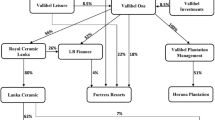Abstract
This paper revisits the rationale for the existence of firm, focusing on the scope of corporate governance and how corporations, especially in India, are trying to expand their objectives from pure financial to social, aligning roles of their various stakeholders, especially shareholders, and the larger society. This paper first looks at how and why shareholders gained more prominence as compared to other groups associated with corporations. It then goes on and analyzes the case for corporate social responsibility and the expanded scope of corporate governance to incorporate the interests of other stakeholder groups, especially the society. Through examples, from corporate sector in India, this paper evaluates the relationship that the Indian corporate has established with society and how the contours of this relationship are shifting. Cases from both the so-called business and social enterprises, where making profits and creating social values, respectively, are cited as primary objectives of existence, are discussed.
Similar content being viewed by others
Notes
- 1.
http://www.tata.in/company/Media/inside.aspx?artid=ZYTmDvfrGd4. Accessed on September 9, 2014.
- 2.
http://www.tata.in/ourcommitment/articlesinside/SRTT-and-NRTT. Accessed on January 9, 2013.
- 3.
http://www.mciindia.org/pdf/Annual%20Report.pdf. Downloaded on January 9, 2013.
- 4.
http://www.measuredhs.com/pubs/pdf/FRIND3/FRIND3-Vol1AndVol2.pdf. Downloaded on January 9, 2013.
- 5.
http://business.outlookindia.com/printarticle.aspx?240800. Accessed on January 11, 2013.
- 6.
- 7.
- 8.
- 9.
References
Anheier, H.K. 2005. Nonprofit Organizations: Theory, Management Policy. London: Routledge.
Banerjee, J. 2010. Project Shakti: Poverty Alleviation Through SHG—Corporate Partnership. Downloaded on August 2012 from http://ssrn.com/abstract=1651373.
Cadbury, A. 1992. Report of the Committee on the Financial Aspects of Corporate Governance. London: Gee.
Carroll, A.B. 1991. The Pyramid of Corporate Social Responsibility: Toward The Moral Management of Organizational Stakeholders. Business Horizons 34: 39–48.
Chitnis, K., Kim, D-K., Singhal, A. and R. Vasanti. 2007. Internet, Sanchalak and e-Choupal: Connecting rural Indian farmers. Paper proceeding for International Communication Association, San Francisco, CA.
Coase, R.H. 1937. The Nature of the Firm. Economica 4: 386–405.
Dees, J.G. 1994. Social Enterprise: Private Initiatives for the Common Good. Harvard Business School Note. Cambridge: Harvard Business School Press.
Dees, J.G. 1998. Enterprising Nonprofits. Harvard Business Review 76 (1): 55–67.
Dees, J.G. 2001. The Meaning of “Social Entrepreneurship.” Center for the Advancement of Social Entrepreneurship, Fuqua School of Business, Duke University, Durham, NC. Downloaded on January 25, 2013 from: http://www.fuqua.duke.edu/centers/case/documents/dees_SE.pdf.
Donaldson, T., and L.E. Preston. 1995. The Stakeholder Theory of the Corporation: Concepts, Evidence and Implications. Academy of Management Review 20 (1): 65–91.
Esposito, M., A. Kapoor, and S. Goyal. 2012. Enabling Healthcare Services for the Rural and Semi-urban Segments in India: When Shared Value Meets the Bottom of the Pyramid. Corporate Governance 12: 514–533.
Foster, W., and J.L. Bradach. 2005. Should Nonprofits Seek Profits? Harvard Business Review 83: 92–100.
Freeman, R., and D. Reed. 1983. Stockholders and Stakeholders: A New Perspective on Corporate Governance. California Management Review 25: 88–106.
Friedman, M. 1970. The Social Responsibility of Business is to Increase its Profits. New York Times Magazine, 122–126.
Gunn, R., and C. Durkin. 2010. Social Entrepreneurship: A Skills Approach. Bristol, UK: Policy Press.
Haugh, H. and Tracey, P. 2004. Role of Social Enterprise in Regional Development. In Cambridge-MIT Institute (eds.) Social Enterprise and Regional Development Conference. Cambridge, England: MIT Institute.
Jensen, M.C., and W.H. Meckling. 1976. Theory of the Firm: Managerial Behaviour, Agency Costs and Ownership Structure. Journal of Financial Economics 3: 305–360.
Karnani, A. 2007. The Mirage of Marketing to the Bottom of the Pyramid. California Management Review 49: 90–111.
Kumar Mangalam Birla Committee. 1999. Report on Corporate Governance. Securities and Exchange Board of India. Downloaded on May 11, 2010 from http://www.sebi.gov.in/commreport/corpgov.html.
Lala, R.M. 2004. The Creation of Wealth: The Tatas from the 19th to the 21st Century. New Delhi: Viking, Penguin Books India.
Lazonick, W., and M.O. Sullivan. 2000. Maximizing Shareholder Value: A New Ideology for Corporate Governance. Economy and Society 29: 13–35.
Mair, J., and I. Marti. 2006. Social Entrepreneurship Research: A Source of Explanation, Prediction, and Delight. Journal of world business 41: 36–44.
Martin, R. 2010. The Age of Customer Capitalism. Harvard Business Review 88: 58–65.
Neath, G., and V. Sharma. 2008. The Shakti Revolution-How the world’s largest Home-to-home Operation is Changing Lives and Stimulating Economic Activity in Rural India Development. Outreach, World Bank Institute, 13–16.
Organization for Economic Co-operation and Development. 2004. OECD Principles of Corporate Governance. Downloaded on March 25, 2010 from http://www.oecd.org/daf/corporateaffairs/corporategovernanceprinciples/31557724.pdf.
Porter, M.E., and M.R. Kramer. 2006. Strategy and Society: The Link between Competitive Advantage and Corporate Social Responsibility. Harvard Business Review 84: 78–92.
Prahalad, C.K. 2006. The Innovation Sandbox. Strategy Business. 44: 1–12. Downloaded on June, 25th from http://www.strategy-business.com/media/file/sb44_06306.pdf.
Reis, Thomas K., and Stephanie J. Clohesy. 1999. Unleashing New Resources and Entrepreneurship for the Common Good. New York: W.K. Kellogg Foundation.
Varman, R., P. Skålén, and R.W. Belk. 2012. Conflicts at the Bottom of the Pyramid: Profitability, Poverty Alleviation, and Neoliberal Governmentality. Journal of Public Policy & Marketing 31: 19–35.
World Bank. 2003. e-Choupal: ITC’s Rural Networking Project. Downloaded on June 5, 2012, from http://siteresources.worldbank.org/INTEMPOWERMENT/Resources/14647_Choupal-eb.pdf(www.echoupal.com).
Websites
Author information
Authors and Affiliations
Corresponding author
Editor information
Editors and Affiliations
Rights and permissions
Copyright information
© 2018 Springer Nature Singapore Pte Ltd.
About this chapter
Cite this chapter
Bajaj, H. (2018). Corporate Governance: At the Crossroads?. In: Sekher, M., Parasuraman, S., Kattumuri, R. (eds) Governance and Governed. Springer, Singapore. https://doi.org/10.1007/978-981-10-5963-6_11
Download citation
DOI: https://doi.org/10.1007/978-981-10-5963-6_11
Published:
Publisher Name: Springer, Singapore
Print ISBN: 978-981-10-5962-9
Online ISBN: 978-981-10-5963-6
eBook Packages: Political Science and International StudiesPolitical Science and International Studies (R0)




